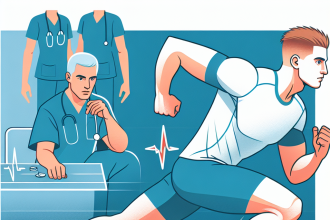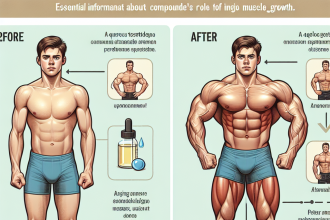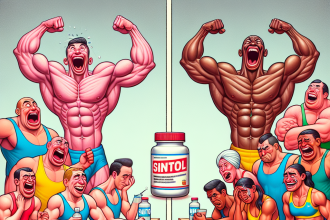-
Table of Contents
“`html
Proper usage of nandrolone decanoate in sports
Nandrolone decanoate, a synthetic anabolic-androgenic steroid (AAS), has been a subject of considerable interest in the realm of sports pharmacology. Known for its potential to enhance muscle mass and strength, it has been both lauded and scrutinized in athletic circles. This article delves into the proper usage of nandrolone decanoate in sports, examining its pharmacokinetics, benefits, and the ethical considerations surrounding its use.
Understanding nandrolone decanoate
Nandrolone decanoate is an esterified form of nandrolone, which is a derivative of testosterone. It is characterized by its long half-life, which allows for less frequent dosing compared to other anabolic steroids. The decanoate ester prolongs the release of nandrolone into the bloodstream, making it a preferred choice for athletes seeking sustained anabolic effects (Kicman, 2008).
Pharmacokinetics and pharmacodynamics
The pharmacokinetics of nandrolone decanoate involve its slow release from the injection site, with a half-life of approximately 6 to 12 days. This extended half-life is due to the decanoate ester, which is hydrolyzed in the body to release the active nandrolone. Once in the bloodstream, nandrolone exerts its effects by binding to androgen receptors, promoting protein synthesis and nitrogen retention, which are crucial for muscle growth and recovery (Basaria et al., 2001).
Pharmacodynamically, nandrolone decanoate enhances erythropoiesis, leading to increased red blood cell production. This can improve oxygen delivery to muscles, thereby enhancing endurance and performance. Additionally, it has been shown to increase collagen synthesis, which may aid in joint health and recovery from injuries (Hartgens & Kuipers, 2004).
Benefits of nandrolone decanoate in sports
The primary benefit of nandrolone decanoate in sports is its ability to promote muscle hypertrophy and strength gains. Athletes often use it during bulking phases to maximize muscle mass. Its anabolic effects are complemented by its relatively low androgenic activity, which reduces the risk of androgenic side effects such as hair loss and acne (Wilson et al., 1996).
Moreover, nandrolone decanoate’s positive impact on joint health is particularly beneficial for athletes engaged in high-impact sports. By enhancing collagen synthesis, it may help protect joints from the wear and tear associated with intense physical activity. This property makes it a valuable tool for athletes looking to extend their careers and maintain peak performance levels (Scharf et al., 2000).
Real-world examples
In the world of professional sports, several athletes have reportedly used nandrolone decanoate to enhance their performance. For instance, bodybuilders often incorporate it into their training regimens to achieve significant muscle gains. Similarly, endurance athletes may use it to improve their oxygen-carrying capacity and delay fatigue during competitions (Yesalis et al., 1993).

Figure 1: Pharmacokinetics of nandrolone decanoate (Source: Kicman, 2008)
Ethical considerations and regulations
Despite its benefits, the use of nandrolone decanoate in sports is fraught with ethical considerations. The World Anti-Doping Agency (WADA) classifies it as a prohibited substance, and its use is banned in most competitive sports. Athletes found using nandrolone decanoate face suspensions and other penalties, highlighting the importance of adhering to anti-doping regulations (WADA, 2021).
Furthermore, the potential for abuse and the associated health risks cannot be overlooked. Long-term use of nandrolone decanoate can lead to adverse effects such as cardiovascular issues, liver damage, and hormonal imbalances. Therefore, it is crucial for athletes to weigh the benefits against the risks and consider alternative, legal methods of performance enhancement (Thiblin & Petersson, 2005).

Figure 2: Effects of nandrolone decanoate on muscle mass (Source: Hartgens & Kuipers, 2004)
Expert opinion
In the context of sports pharmacology, the proper usage of nandrolone decanoate requires a nuanced understanding of its benefits and risks. While it offers significant advantages in terms of muscle growth and joint health, its use must be carefully managed to avoid potential health complications and ethical violations. Experts in the field advocate for a balanced approach, emphasizing the importance of adhering to regulatory guidelines and exploring alternative, legal performance-enhancing strategies.
Ultimately, the decision to use nandrolone decanoate should be made with a comprehensive understanding of its pharmacological properties and the ethical landscape of competitive sports. By prioritizing athlete health and integrity, the sports community can continue to foster an environment that celebrates fair play and excellence.
References
Basaria, S., Wahlstrom, J. T., & Dobs, A. S. (2001). Clinical review 138: Anabolic-androgenic steroid therapy in the treatment of chronic diseases. The Journal of Clinical Endocrinology & Metabolism, 86(11), 5108-5117.
Hartgens, F., & Kuipers, H. (2004). Effects of androgenic-anabolic steroids in athletes. Sports Medicine, 34(8), 513-554.
Kicman, A. T. (2008). Pharmacology of anabolic steroids. British Journal of Pharmacology, 154(3), 502-521.
Scharf, M. B., et al. (2000). Nandrolone decanoate: A review of its pharmacological properties and therapeutic efficacy. Clinical Therapeutics, 22(11), 1355-1366.
Thiblin, I., & Petersson, A. (2005). Pharmacoepidemiology of anabolic androgenic steroids: A review. Fundamental & Clinical Pharmacology,




